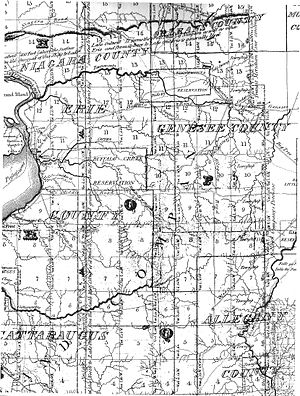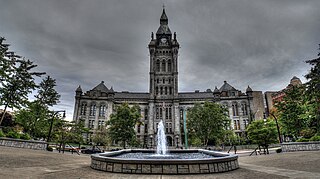
Erie County is a county along the shore of Lake Erie in western New York State. As of the 2020 census, the population was 954,236. The county seat is Buffalo, which makes up about 28% of the county's population. Both the county and Lake Erie were named for the regional Iroquoian language-speaking Erie tribe of Native Americans, who lived in the area before 1654. They were later pushed out by the more powerful Iroquoian nations tribes.

Livingston County is a county in the U.S. state of New York. As of the 2020 census, the population was 61,834. Its county seat is Geneseo. The county is named after Robert R. Livingston, who helped draft the Declaration of Independence and negotiated the Louisiana Purchase.
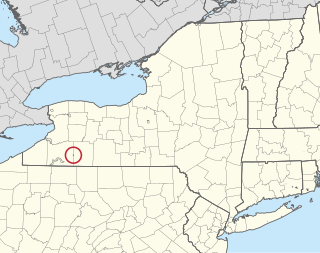
Oil Springs Reservation or Oil Spring Reservation is an Indian reservation of the federally recognized Seneca Nation that is located in southwestern New York, United States. As of the 2010 census, the Indian reservation had one resident; in 2005 no tribal members had lived on the property. The reservation covers about one square mile (2.6 km2), divided between the present-day counties of Allegany and Cattaraugus. The reservation is northwest of the village of Cuba. It is bordered by the Town of Cuba and the Town of Ischua.
The Pulteney Association was a small group of British investors who in 1792 purchased a large portion of the Western New York land tract known as the Phelps and Gorham Purchase. The Pulteney Associates were Sir William Pulteney, 5th Baronet (1729–1805), a Scottish lawyer who owned nine-twelfths; William Hornby, former Governor of Bombay, who owned two-twelfths; and Patrick Colquhoun, a Scottish merchant with a one-twelfth share. Some of their heirs owned land in western New York into the 1920s, with the last parcel of The Pulteney Association property, 10 acres, being sold in December 1926.

The Genesee River is a tributary of Lake Ontario flowing northward through the Twin Tiers of Pennsylvania and New York in the United States. The river contains several waterfalls in New York at Letchworth State Park and Rochester.

The Phelps and Gorham Purchase was the sale, in 1788, of a portion of a large tract of land in western New York State owned by the Seneca nation of the Iroquois Confederacy to a syndicate of land developers led by Oliver Phelps and Nathaniel Gorham. The larger tract of land is generally known as the "Genesee tract" and roughly encompasses all that portion of New York State west of Seneca Lake, consisting of about 6,000,000 acres (24,000 km2).

Joseph Ellicott was an American surveyor, city planner, land office agent, lawyer and politician of the Quaker faith.

Willem Willink was a wealthy Amsterdam merchant, and one of the investors in the Holland Land Company, and the Louisiana Purchase.
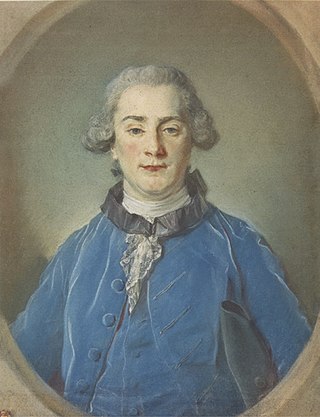
Theophilus Cazenove, or Theophile Cazenove, was a Dutch financier and one of the agents of the Holland Land Company.

Paul Busti was the Agent General of the Holland Land Company from 1799 until his death in 1824. As administrator of the Holland Land Company, Busti was responsible for the economic, political, and social development of large areas of central and western New York and northwestern Pennsylvania.
There are four treaties of Buffalo Creek, named for the Buffalo River in New York. The Second Treaty of Buffalo Creek, also known as the Treaty with the New York Indians, 1838, was signed on January 15, 1838 between the Seneca Nation, Mohawk nation, Cayuga nation, Oneida Indian Nation, Onondaga (tribe), Tuscarora (tribe) and the United States. It covered land sales of tribal reservations under the U.S. Indian Removal program, by which they planned to move most eastern tribes to Kansas Territory west of the Mississippi River.
The Tonawanda Seneca Nation is a federally recognized tribe in the State of New York. They have maintained the traditional form of government led by sachems selected by clan mothers. The Seneca are one of the original Five Nations of the Haudenosaunee or Iroquois Confederacy. Their people speak the Seneca language, an Iroquoian language.

The Preemption Line divided the aboriginal lands of western New York State awarded to New York from those awarded to Commonwealth of Massachusetts by the Treaty of Hartford of 1786. It was defined as the meridian (north–south) line from the eighty-second milestone of the Pennsylvania–New York survey line at 76° 57' 58" W northward to Lake Ontario.
Canawaugus was a Seneca Indian village. The village was located on the west side of the Genesee River, "about a mile above the ford", on the eastern edge of the Town of Caledonia. It was nearly opposite of the Avon sulphur springs. The name means "stinking waters" because of the sulphur.

The Buffalo Creek Reservation was a tract of land surrounding Buffalo Creek in the central portion of Erie County, New York. It contained approximately 49,920 acres (202.0 km2) of land and was set aside for the Seneca Nation following negotiations with the United States after the American Revolutionary War.

The Holland Land Office building is located on West Main Street in downtown Batavia, New York, United States. It is a stone building designed by surveyor Joseph Ellicott and erected in the 1810s.
Willink, New York is a former town in Western New York, United States. The name was derived from Willem Willink, one of the original investors of the Holland Land Company.
The Treaty of Big Tree was a formal treaty signed in 1797 between the Seneca Nation and the United States, in which the Seneca relinquished their rights to nearly all of their traditional homeland in New York State—nearly 3.5 million acres. In the 1788 Phelps and Gorham Purchase, the Haudenosaunee (Iroquois) had previously sold rights to their land between Seneca Lake and the Genesee River. The Treaty of Big Tree signed away their rights to all their territory west of the Genesee River except 12 small tracts of land for $100,000 and other considerations. The money was not paid directly to the tribe, but was to be invested in shares of the Bank of the United States, and to be paid out to the Senecas in annual earnings of up to six percent, or $6,000 a year, on the bank stock.
Fellows v. Blacksmith, 60 U.S. 366 (1857), is a United States Supreme Court decision involving Native American law. John Blacksmith, a Tonawanda Seneca, sued agents of the Ogden Land Company for common law claims of trespass, assault, and battery after he was forcibly evicted from his sawmill by the Company's agents. The Court affirmed a judgement in Blacksmith's favor, notwithstanding the fact that the Seneca had executed an Indian removal treaty and the Company held the exclusive right to purchase to the land by virtue of an interstate compact ratified by Congress.
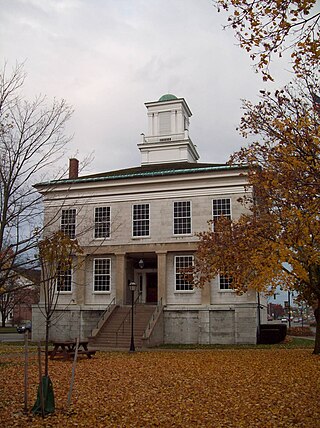
Batavia is a city in and the county seat of Genesee County, New York, United States. It is near the center of the county, surrounded by the Town of Batavia, which is a separate municipality. Batavia's population as of the 2020 census was 15,600. The name Batavia is Latin for the Betuwe region of the Netherlands, and honors early Dutch land developers. In 2006, a national magazine, Site Selection, ranked Batavia third among the nation's micropolitans based on economic development. The New York State Thruway passes north of the city. Genesee County Airport (GVQ) is also north of the city.
